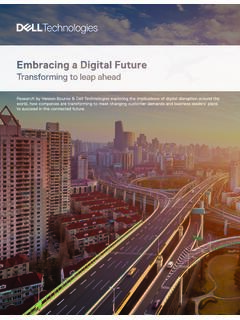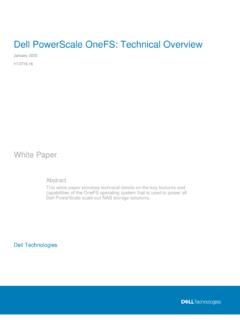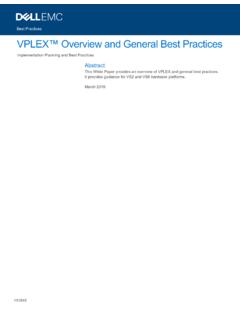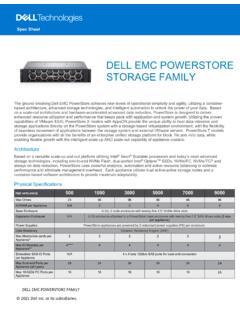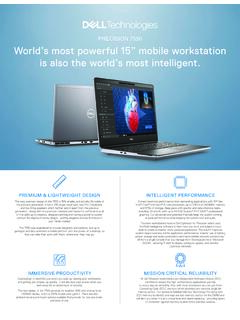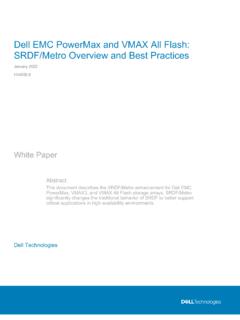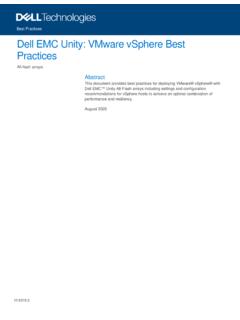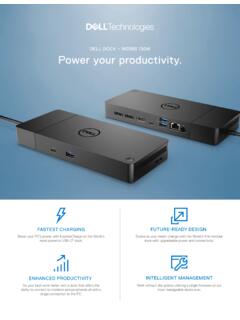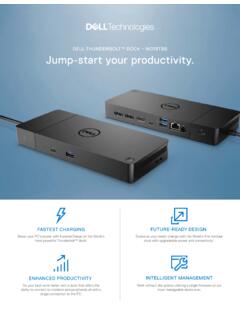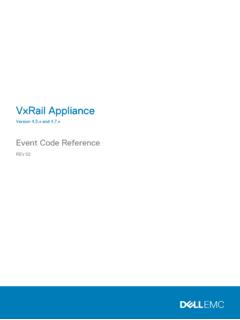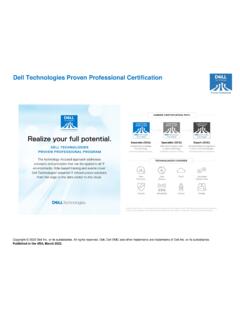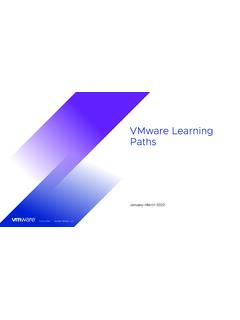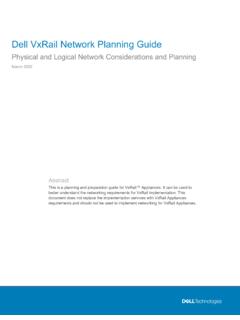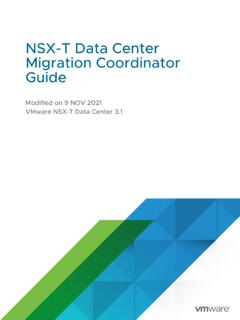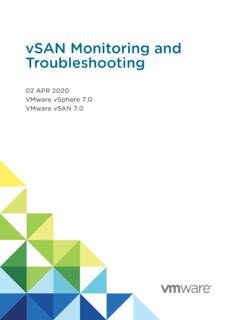Transcription of vSAN 2-Node Cluster on VxRail Planning Guide
1 vsan 2-Node Cluster on VxRail Planning Guide January 2021. Abstract This Guide provides information for the Planning of a VMware vsan . 2-Node Cluster infrastructure on a VxRail platform. This Guide focuses on the VxRail implementation of the vsan 2-Node Cluster , including minimum requirements and recommendations. Copyright The information in this publication is provided as is. Dell Inc. makes no representations or warranties of any kind with respect to the information in this publication, and specifically disclaims implied warranties of merchantability or fitness for a particular purpose.
2 Use, copying, and distribution of any software described in this publication requires an applicable software license. Copyright 2021 Dell Inc. or its subsidiaries. All Rights Reserved. Dell Technologies, Dell, EMC, Dell EMC and other trademarks are trademarks of Dell Inc. or its subsidiaries. Intel, the Intel logo, the Intel Inside logo and Xeon are trademarks of Intel Corporation in the and/or other countries. Other trademarks may be trademarks of their respective owners. Published in the USA 01/21.
3 Dell Inc. believes the information in this document is accurate as of its publication date. The information is subject to change without notice. 2 vsan 2-Node Cluster on VxRail Planning Guide Contents Contents Revision history ..4. Overview ..4. Requirements, Recommendations, and Restrictions ..5. Deployment Types ..13. References ..15. vsan 2-Node Cluster on VxRail Planning Guide 3. Revision history Revision history Date Description June 2019 Removed Remote or Branch Office (ROBO) licensing requirement March 2020 Updated to support switch changes made in VxRail May 2020 Updated to support VxRail July 2020 Updated to add D-series to the supported hardware section November 2020 Updated NIC requirements January 2021 Support for 2+ nodes in , added hardware, updated LCM statement Overview VMware vsan 2-Node Cluster is a configuration that is implemented in environments where a minimal configuration is a key requirement.
4 VxRail was the first release to support the vsan 2-Node Cluster with direct- connect configuration. Starting with VxRail , vsan 2-Node Cluster with switch configuration is also supported. Note: A minimum of four ports are required for both configurations. This Guide provides information for the Planning of a vsan 2-Node Cluster infrastructure on a VxRail platform. This Guide focuses on the VxRail implementation of the vsan 2- node Cluster , including minimum requirements and recommendations. For detailed information about VMware vsan 2-Node Cluster architecture and concepts, see the VMware vsan 2-Node Guide .
5 Introduction A VMware vsan 2-Node Cluster on VxRail consists of a Cluster with two VxRail nodes, and a Witness host deployed as a virtual appliance. The VxRail Cluster is deployed and managed by VxRail Manager and VMware vCenter Server. A vsan 2-Node configuration is very similar to a stretched- Cluster configuration. If there is a failure, the Witness host is the component that provides quorum for the two data nodes. As in a stretched- Cluster configuration, the requirement for one Witness per Cluster still applies.
6 Unlike a stretched Cluster , the vCenter Server and the Witness host are typically located in a main data center, as shown in Figure 1. The two vsan data nodes are typically deployed in a remote location. Even though the Witness host can be deployed at the same site as the data nodes. The most common deployment for multiple 2-Node clusters is to have multiple Witnesses hosted in the same management Cluster as the vCenter Server. This deployment optimizes the infrastructure cost by sharing the vSphere licenses and the management hosts.
7 4 vsan 2-Node Cluster on VxRail Planning Guide Requirements, Recommendations, and Restrictions This design is facilitated by the low bandwidth that is required for the communication between data nodes and the Witness. A vsan 2-Node configuration maintains the same high availability characteristics as a regular Cluster . Each physical node is configured as a vsan fault domain. This means that the virtual machines can have one copy of data on each fault domain. If a node or a device fails, the virtual machine remains accessible through the alternate replica and Witness components.
8 When the failed node is restored, the Distributed Resource Scheduler (DRS). automatically rebalances the virtual machines between the two nodes. DRS is not required but highly recommended. It requires a vSphere Enterprise edition license or higher. Requirements, Recommendations, and Restrictions VxRail hardware The vsan 2-Node configuration is supported using the VxRail D560/F, E560, E560F/N, E665/F/N, P570/F, P675F, V570/F, and S570 appliances. The systems can be configured with the following Network Daughter Cards: Starting with , 25 GbE is supported.
9 VxRail earlier than : 4 x 10 GbE. 2 x 1 GbE + 2 x 10 GbE. VxRail : 4 x 10 GbE. 2 x 1 GbE + 2 x 10 GbE. Customer-Supplied VDS (still requires four ports). VxRail : 4 x 10 GbE. 2 x 1 GbE + 2 x 10 GbE. 4 x 25 GbE (2 x 25 GbE on NDC + 2 x 25 GbE on PCIe). Customer-Supplied VDS (still requires four ports). VxRail software VxRail or later supports the vsan 2-Node Cluster with direct-connect configuration. version VxRail or later supports the vsan 2-Node Cluster with switch configuration. VMware vCenter The vsan 2-Node Cluster must be connected to an external vCenter Server at the time of Server its deployment.
10 VxRail -supplied vCenter is not supported. VMware vCenter Server version requirements: vsan 2-Node Cluster on VxRail Planning Guide 5. Requirements, Recommendations, and Restrictions Version or later is required for 2-Node Cluster with direct-connect configuration. Version or later is required for switch configurations. The vCenter Server must be deployed before the deployment of the 2-Node Cluster . vCenter Server cannot be deployed on the 2-Node Cluster . Witness virtual VMware supports both physical ESXi hosts and a virtual appliance as a vsan Witness appliance host.
